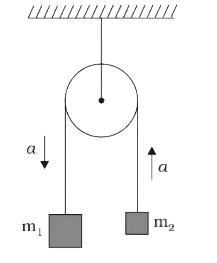Two masses m1 and m2(m1>m2) are falling from the same height when same air resistance acts on them
m1 has more acceleration
m1 reaches the ground early
m1 has more velocity on striking the ground
all the above
The correct Answer is:D
To solve the problem, we need to analyze the forces acting on two masses, m1 and m2, as they fall under the influence of gravity and experience the same air resistance.
1. Identify Forces Acting on the Masses:
- The gravitational force acting on mass m1 is Fg1=m1g.
- The gravitational force acting on mass m2 is Fg2=m2g.
- Both masses experience the same air resistance Fr.
2. Write the Net Force Equations:
- For mass m1:
Fnet1=m1g−Fr
- For mass m2:
Fnet2=m2g−Fr
3. Apply Newton's Second Law:
- According to Newton's second law, Fnet=m⋅a.
- For mass m1:
m1g−Fr=m1a1(1)
- For mass m2:
m2g−Fr=m2a2(2)
4. Rearranging the Equations:
- Rearranging equation (1):
a1=m1g−Frm1
- Rearranging equation (2):
a2=m2g−Frm2
5. Comparing Accelerations:
- Since m1>m2 and both experience the same air resistance Fr, we can compare a1 and a2:
- The term m1g will be greater than m2g because m1>m2.
- Thus, a1 will be greater than a2:
a1>a2
6. Conclusion:
- Since a1>a2, mass m1 will accelerate faster than mass m2.
- Therefore, mass m1 will reach the ground before mass m2 and will have a greater velocity upon impact.
Final Answer:
All the statements regarding the scenario are correct. Thus, the correct option is that m1 reaches the ground first and has a greater velocity upon impact.
---
- The gravitational force acting on mass m1 is Fg1=m1g.
- The gravitational force acting on mass m2 is Fg2=m2g.
- Both masses experience the same air resistance Fr.
- For mass m1:
Fnet1=m1g−Fr
- For mass m2:
Fnet2=m2g−Fr
- According to Newton's second law, Fnet=m⋅a.
- For mass m1:
m1g−Fr=m1a1(1)
- For mass m2:
m2g−Fr=m2a2(2)
- Rearranging equation (1):
a1=m1g−Frm1
- Rearranging equation (2):
a2=m2g−Frm2
- Since m1>m2 and both experience the same air resistance Fr, we can compare a1 and a2:
- The term m1g will be greater than m2g because m1>m2.
- Thus, a1 will be greater than a2:
a1>a2
- Since a1>a2, mass m1 will accelerate faster than mass m2.
- Therefore, mass m1 will reach the ground before mass m2 and will have a greater velocity upon impact.
All the statements regarding the scenario are correct. Thus, the correct option is that m1 reaches the ground first and has a greater velocity upon impact.
Similar Questions
Two bodies of masses m1andm2(<m1) are connected to the ends of a massless cord and allowed to move as shown in figure. The pulley is both massless and frictionless. The acceleration of the centre of mass is (m1−m2)n(m1+m2)2g. Find the value of n.

View SolutionAssertion: Two bodies of masses M and m(M>m) are allowed to fall from the same height if the air resistance for each be the same then both the bodies will reach the earth simultaneously.
Reason: For same air resistance, acceleration of both the bodies will be same.
View SolutionTwo particles of masses m1 and m2 (m1>m2) are separated by a distance d. The shift in the centre of mass when the two particles are interchanged.
View SolutionTwo small balls of the same size and of mass m1 and m2(m1>m2) are tied by a thin light thread and dropped from a large height. Determine the tension T of the thread during the flight after the motion of the balls has become steady. (Air resistance force is same on two balls)
[Take m1=2kg, m2=1kg, g=10m/s2]
View SolutionTwo masses m1 and m2(m2>m1) are hanging vertically over frictionless pulley. The acceleration of the two masses is :

View SolutionTwo masses m1 and m2(m2>m1) are hanging vertically over frictionless pulley. The acceleration of the two masses is :

View SolutionTwo small balls of the same size and of mass m1 and m2(m1>m2) are tied by a thin weightless thread and dropped from a ballon. Determine the tension T of the thread during the flight after the motion of the balls has become steady-state.
View SolutionAssertion : Two bodies of unequal masses m1andm2 are dropped from the same height. If the resistance offered by air to the motion of both bodies is the same, the bodies will reach the earth at the same time.
Reason : For equal air resistance, acceleration of fall of masses m1andm2 will be different.
View SolutionTwo bodies of masses M and m are allowed to fall from the same height. It the resistance for each be the same, then, will both the bodies reach the earth simultaneously ?
View SolutionTwo equal and opposite charges of masses m1 and m2 are accelerated in a uniform electric field through the same distance. What is the ratio of their accelerations, if their ratio of masses is m1m2=0.5?
View Solution
